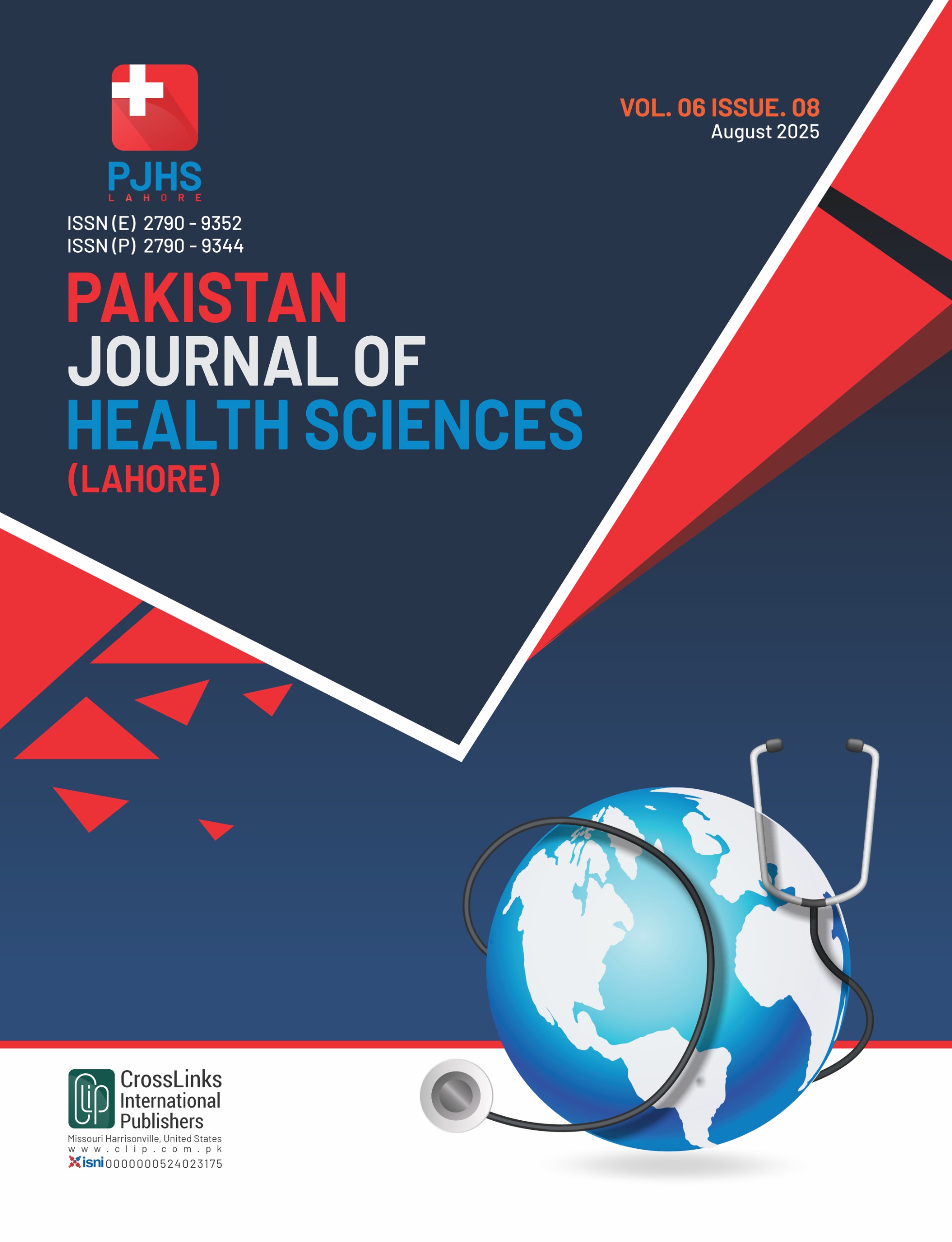Frequency and Clinical Risk Factors of Pneumonia among Children with Cerebral Palsy
Pneumonia among Children with Cerebral Palsy
DOI:
https://doi.org/10.54393/pjhs.v6i8.3422Keywords:
Cerebral Palsy, Pneumonia, Aspiration, Feeding Methods, Respiratory Infections, Pediatrics, Nutritional Status, ImmunizationAbstract
Children with cerebral palsy (CP) are prone to various comorbidities, among which pneumonia is a leading cause of morbidity and hospitalization. Early identification of contributing factors is crucial to minimize respiratory complications. Objectives: To determine the frequency of pneumonia and identify associated clinical risk factors among children diagnosed with cerebral palsy. Methods: This cross-sectional study was conducted at the Pediatrics Unit, Khyber Teaching Hospital, Peshawar, for six months. Ninety-three children with confirmed CP were enrolled through consecutive sampling. Data on demographics, feeding methods, CP severity, nutritional status, immunization, and aspiration history were collected. Pneumonia was diagnosed clinically and radiologically. Statistical analysis was performed using SPSS version 26.0, and associations were tested using the Chi-square. Results: Among 93 children, 38 (40.9%) had pneumonia. Strong associations were observed with aspiration history (χ² = 85.14, p<0.001, Cramer’s V = 0.957), feeding method (χ² = 32.13, p<0.001, Cramer’s V = 0.588), immunization status (χ² = 74.72, p<0.001, Cramer’s V = 0.896), and nutritional status (χ² = 52.32, p<0.001, Cramer’s V = 0.750). Interestingly, no pneumonia cases occurred in children with severe CP or those who were severely malnourished. Conclusions: Pneumonia is highly prevalent in children with CP and is strongly linked to aspiration and oral feeding. Unexpected findings, such as the absence of pneumonia in severe CP and malnourished children, highlight the need to consider contextual exposure and monitoring factors. Targeted prevention strategies, including caregiver education, aspiration management, and individualized nutritional support, are essential to reduce respiratory complications in this vulnerable population.
References
Tanaka N, Nohara K, Uota C, Fujii N, Obana A, Tanaka K et al. Relationship Between Daily Swallowing Frequency and Pneumonia in Patients With Severe Cerebral Palsy. BioMed Central Pediatrics. 2022 Aug; 22(1): 485. doi: 10.1186/s12887-022-03547-0. DOI: https://doi.org/10.1186/s12887-022-03547-0
Kürtül Çakar M, Cinel G. The Respiratory Problems of Patients with Cerebral Palsy Requiring Hospitalization: Reasons and Solutions. Pediatric Pulmonology. 2021 Jun; 56(6): 1626-34. doi: 10.1002/ppul.25306. DOI: https://doi.org/10.1002/ppul.25306
Liu FH, Huang JY, Chang YC. The Relationship Between Pneumonia and Dental Visits in Patients with Cerebral Palsy: A Nationwide Registry-Based Cohort Study in Taiwan. Journal of Dental Sciences. 2025 Jan; 20(1): 118-25. doi: 10.1016/j.jds.2024.09.019. DOI: https://doi.org/10.1016/j.jds.2024.09.019
Kuo TJ, Hsu CL, Liao PH, Huang SJ, Hung YM, Yin CH. Nomogram for Pneumonia Prediction among Children and Young People with Cerebral Palsy: A Population-Based Cohort Study. PLOS One. 2020 Jul; 15(7): e0235069. doi: 10.1371/journal.pone.0235069. DOI: https://doi.org/10.1371/journal.pone.0235069
Stevens JD, Turk MA, Landes SD. Cause of Death Trends Among Adults with and without Cerebral Palsy in The United States, 2013–2017. Annals of Physical and Rehabilitation Medicine. 2022 Mar; 65(2): 101553. doi: 10.1016/j.rehab.2021.101553. DOI: https://doi.org/10.1016/j.rehab.2021.101553
Khan SA, Talat S, Malik MI. Risk Factors, Types, and Neuroimaging Findings in Children with Cerebral Palsy. Pakistan Journal of Medical Sciences. 2022 Sep; 38(7): 1738. doi: 10.12669/pjms.38.7.6175. DOI: https://doi.org/10.12669/pjms.38.7.6175
Iqbal N, Zafar F, Iqbal M. Factors Influencing the Outcome of Severe Pneumonia among Children Having Age from 2 Months to 5 Years in A Tertiary Healthcare Hospital: Factors Influencing the Outcome of Severe Pneumonia. Pakistan Journal of Health Sciences. 2023 Jan: 60-5. doi: 10.54393/pjhs.v4i01.480. DOI: https://doi.org/10.54393/pjhs.v4i01.480
Whitney DG, Xu T, Berri M. Post-Fracture Pneumonia Risk and Association with Health and Survival Outcomes for Adults with Cerebral Palsy: A Retrospective Cohort Study. Bone. 2022 Jun; 159: 116390. doi: 10.1016/j.bone.2022.116390. DOI: https://doi.org/10.1016/j.bone.2022.116390
Whitney DG. Development and Temporal-Validation of Prognostic Models for 5-Year Risk of Pneumonia, Respiratory Failure/Collapse, and Fracture Among Adults with Cerebral Palsy. Advances in Medical Sciences. 2025 Mar; 70(1): 109-16. doi: 10.1016/j.advms.2025.01.007. DOI: https://doi.org/10.1016/j.advms.2025.01.007
Mpody C, Hayes S, Rusin N, Tobias JD, Nafiu OO. Risk Assessment for Postoperative Pneumonia in Children Living with Neurologic Impairments. Pediatrics. 2021 Sep; 148(3): e2021050130. doi: 10.1542/peds.2021-050130. DOI: https://doi.org/10.1542/peds.2021-050130
Kopiyka GK, Kravchenko TY, Lotysh NG, Zaretska VV. Features of the Community-Acquired Pneumonia Course in Children with Cerebral Palsy. Fractures of the talus: Current concepts and new developments. Foot and Ankle Surgery. 2018; 4(24): 282–290.
Aishauova RR, Abdrakhmanova ST, Meshcheryakov VV. Features of Community-acquired Pneumonia in Children with Children's Cerebral Paralysis. Acta Scientific Nutritional Health. 2021; 5(7): 57-63. doi: 10.31080/ASNH.2020.05.0892. DOI: https://doi.org/10.31080/ASNH.2020.05.0892
Peneva P, Pancheva R, Nikolova SP. Unveiling Respiratory Challenges in Cerebral Palsy: A Comprehensive Review. Biomedical Reviews. 2023 Dec; 34: 121-32. doi: 10.14748/bmr.v34.9620. DOI: https://doi.org/10.14748/bmr.v34.9620
Amer AR, Sobeih AA, Hekal HH. Respiratory Complications in Children with Cerebral Palsy. Benha Medical Journal. 2024 Mar; 41(1): 233-45. doi: 10.21608/bmfj.2024.263581.2001. DOI: https://doi.org/10.21608/bmfj.2024.263581.2001
Strzalkowski AJ, Melvin P, Mauskar S, Stringfellow I, Berry JG. Postoperative Pneumonia Risk in Children with Neurologic and Neuromuscular Disorders. Hospital Pediatrics. 2024 Dec; 14(12): 1001-8. doi: 10.1542/hpeds.2023-007618. DOI: https://doi.org/10.1542/hpeds.2023-007618
Spoto G, Accetta AS, Grella M, Di Modica I, Nicotera AG, Di Rosa G. Respiratory Comorbidities and Complications of Cerebral Palsy. Developmental Neurorehabilitation. 2024 Aug; 27(5-6): 194-203. doi: 10.1080/17518423.2024.2374959. DOI: https://doi.org/10.1080/17518423.2024.2374959
Jonsson U, Eek MN, Sunnerhagen KS, Himmelmann K. Health Conditions in Adults with Cerebral Palsy: The Association with CP Subtype and Severity of Impairments. Frontiers in Neurology. 2021 Oct; 12: 732939. doi: 10.3389/fneur.2021.732939. DOI: https://doi.org/10.3389/fneur.2021.732939
Gordon B, Nyiro JU, Nair H, Sheikh Z, Katama E, Agoti CN et al. External Validation of Pediatric Pneumonia and Bronchiolitis Risk Scores to Predict Mortality in Children Hospitalized in Kenya: A Retrospective Cohort Study. The Journal of Infectious Diseases. 2025 Jul: jiaf377. doi: 10.1093/infdis/jiaf377. DOI: https://doi.org/10.1093/infdis/jiaf377
Rafique A and Naz H. A Retrospective Cohort Study of Probable Risk Factors for Cerebral Palsy in Karachi, Pakistan. Rawal Medical Journal. 2023 May; 48(2): 452-7.
Qureshi D, Bano S, Idrees H, Iram S. Identifying Frequency and Associated Factors with Respiratory Illnesses in Children with Cerebral Palsy. The Professional Medical Journal. 2020 Jun; 27(06): 1187-93. doi: 10.29309/TPMJ/2020.27.06.4010. DOI: https://doi.org/10.29309/TPMJ/2020.27.06.4010
Downloads
Published
How to Cite
Issue
Section
License
Copyright (c) 2025 Pakistan Journal of Health Sciences

This work is licensed under a Creative Commons Attribution 4.0 International License.
This is an open-access journal and all the published articles / items are distributed under the terms of the Creative Commons Attribution License, which permits unrestricted use, distribution, and reproduction in any medium, provided the original author and source are credited. For comments













